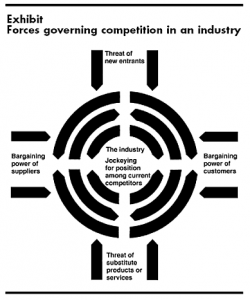Competitive strategy, or Strategic Force, is a concept that allows the identification of the competitiveness and profitable potential of a business.
Since 1979, with the publication of an article entitled “How Competitive Forces Shape Strategy” by Michael E. Porter, the definition has been explored in the business world.
Read below and learn more about this concept and its application in Procurement 4.0.
What is Strategic Force?
Professor at the renowned Harvard Business School, in the areas of Administration and Economics, Michael Porter, who is also the author of several books on competitiveness strategies, developed the concept he called Strategic Force.
According to him, there are five competitive forces that determine the potential profitability of an industry or sector of activity. For Porter, the state of competition in a sector depends on five basic forces, as outlined below:

With this model, describing strengths in sectors and identifying competitive strengths becomes easier for purchasing and supply chain professionals. Let’s look at the most important points of Michael Porter’s five strengths:
Strength 1 – Intensity of competitive rivalry
Competition allows professionals in the purchasing and supply chain industries to analyze the speed of growth in the industry.
That is why it is important to use strategies to accompany the growth of competitors, without leaving aside the evolution of the product in the market. To analyze the strength of the competition, try to answer the following questions:
- How many competitors does your company have?
- Who are these competitors?
- What is the quality of the products and services they offer?
- Comparing the competitor’s products with yours, what are the competitor’s strengths and weaknesses?
This information will allow you to identify the level of rivalry and develop a plan that includes price and marketing campaigns, for example. If the competition is very intense, discounts and advertising should be more aggressive, but with little competitive rivalry, your brand is likely to have more space and higher profits.
Strength 2 – Threat of new participants
It refers to the likelihood that your customers will find a different way to get the products and/or services you offer.
Imagine a company that offers a unique solution for automating an important process, with a wide portfolio of customers. If, over time, your customers find it more advantageous to outsource the services than to purchase the tool, there will be a real threat to the profitability of the organization.
That’s why it’s so important to be able to monitor new market participants, and understand their innovation processes and technology to improve their products and services.
Strength 3 – Threat of substitute products or services
Evaluate constantly: can your position be affected by the ability of other companies to enter your market? Is it easy to get a position in your industry? What is the cost for this – high, low, medium?
It is essential to have the ability to do this analysis, and identify ways to diversify or optimize the product/service that is already offered. Thus, it is possible to remain in alignment with market demands, without giving gaps for “substitute products” to be inserted in the market by rival companies.
Strength 4 – Consumer bargaining power
The questions to identify the bargaining level of your buyers are: How many customers does my company have and how big are their orders? Would it be difficult for them to stop acquiring my products and services and seek a competitor? Is the strength my customers have enough to influence my company and products?
The answers to these questions will determine whether or not your customers have the strength to lower their prices or change the products/services offered.
Strength 5 – bargaining power of suppliers
In this last strength, the power of suppliers and the possibility of increasing prices are considered. Try answering: Who and how many are your suppliers? Is what they offer something exclusive? How much would it cost to change suppliers?
Of course, the fewer suppliers you have and the more dependent your company is on them, the greater the risk you run of higher prices being charged – which could affect your profit margin.
On this issue, we suggest reading this article which shows the benefits offered by companies specialized in the purchase of indirect materials, among them, the ability to interact quickly with suppliers around the world, which helps you obtain better prices in negotiations.
Strategic Force in Procurement 4.0
The Global SciQuest 2017 Survey, conducted by Cision PR Newswire with over 500 purchasing professionals, revealed that the sector is evolving and is increasingly important to organizational strategy. Among the information obtained by the survey, we highlight:
- 25% of the professionals believe that purchasing is a profit center in their companies;
- 72% said they are accessing data to have greater visibility of the supplier and thus conduct their business decisions;
- 67% of purchasing professionals said they expect greater recognition for the sector, as there is a requirement for purchasing to offer savings and value to their organizations.
And if the scope of the work is evolving to become increasingly strategic, the concept born at Harvard shows itself to be extremely advantageous for the 4.0 purchasing department.
The analysis and application of Michael Porter’s theory in the sector allows it, among other benefits, to examine the current status of the sector, pinpoint its strengths and competitive forces; identify and minimize risks related to suppliers; observe and understand the market, including competition.
Methods that extend the intelligence of the procurement industry are indeed welcome. Among them the optimization of the purchasing process, through the services of a company specialized in acquiring indirect materials.
This is the case of Soluparts, which has access to over 15,000 brands around the world and therefore offers the best commercial conditions and greater security in the purchase of indirect materials for your company.
Try our services: request a quote!

